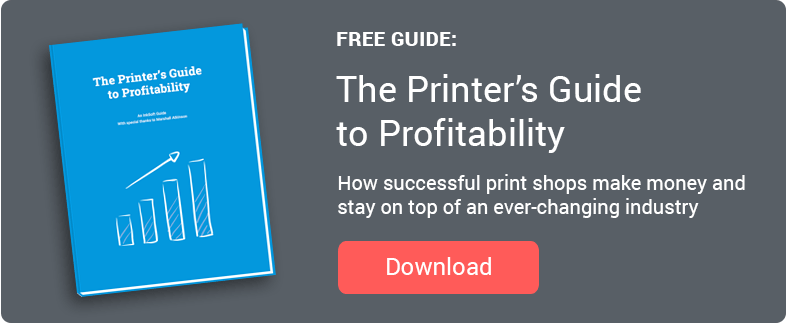This article was originally shared on the Ryonet blog.
It’s true what they say: “One man’s trash is another man’s treasure.” But in the pricing world, that cute little idiom takes on a whole new meaning.
Every print shop owner knows that your customers might adore your products, but there will always be someone who thinks your prices are too high. But this doesn’t mean you need to shove all the penny-pinchers out the door and focus only on courting the big boys. Instead, you can have a more balanced approach with a simple pricing hack called versioning.
How versioning works
As a business owner, you want to price fairly. You may offer an average-quality product with a good print at a reasonable margin. Over time, you might find that this mid-level product has become a bestseller and brings in relatively steady revenue.
But what many businesses miss is that the popularity of a single product like this poses a bigger opportunity for growth.
Versioning your products means offering tiered product options””different versions of the same product at different price points. Another way to understand versioning is to think of it as good, better, best. You have a “good” product that gets the job done. The “better” product has more features that the majority of buyers want. And the “best” option has all the bells and whistles.
Following this model, you offer not only your standard product, but also a simplified version and a souped-up version. The simplified version appeals to cost-conscious buyers, and the fancy version is for those customers who like to have the best of the best ever time. This lets you spread the net wide and capture attention from both ends of the buyer spectrum.
So versioning is awesome from a pricing standpoint. But it also can have a real impact on your sales process. Imagine doing away with all those awkward pricing conversations! When you offer three clear options, your customers feel empowered to select the solution they feel is best for them. Versioning doesn’t make assumptions, but instead requires you to learn what’s important to the client. Meanwhile, you get to have a much more natural conversation and avoid sounding like a salesperson.
Implementing the good, better, best model into your business can be a game changer. Here’s how to begin crafting your own product tiers:
1) Start with the middle ground
What is the product that you think fits the majority of your customers’ needs? For example, do you have a best-selling T-shirt that buyers lean toward at least half the time?
This will be your “better” product. Your standard option. Now, it’s important to ask yourself: Does this product meet the needs of the majority of my customers? You might notice that most customers want a tri-blend shirt and two to three different ink colors, for example. Don’t be afraid to set clear specifications for your standard product. Those who want more will opt for the higher tier instead.

2) Define the simplified version
It’s important to note that the “good” version of your product is just that””it’s good. It still meets your quality standards. However, it’s different from your standard offering because it’s a bit simpler.
Using the T-shirt example, a “good” option might be a plain white, cotton T-shirt with a single color print. It is still a quality product, but it’s basic.
When it comes to pricing your lowest-cost version, don’t put a huge price difference between the “good” option and the “better” option. This is the key to making versioning work in real life. If there’s a big gap in price, the buyer will see the “good” option as an awesome deal and you’ll end up selling a bunch of low-priced products. But if the price difference is small, they’ll realize that the “good” option is alright, but for just a little bit more they can have a much better product.
3) Determine your bells and whistles
Once you have your standard and cost-conscious versions settled, take some time to explore ways to appeal to buyers who want the best of the best.
Your “best” option might be a package with special effects printing techniques, inks, and additives to create a unique, premium product. Maybe you even throw in personalization options and free shipping.
You can charge a significantly higher price for this tier, especially when it takes more of your time. The buyers who want these features will pay for them.
How to make versioning work for your printing business
The good, better, best format might feel pretty cut-and-dry, but remember that it’s not a perfect science. Here are some ideas for making the framework work for you:
Create physical examples
Want to get the most out of versioning? Create a set of physical samples that you can bring to each meeting with prospective customers and use over and over again. Let the customer touch and see the difference between good, better, and best. This will be a far more effective way to help them choose than simply handing them a flier with a few bullet points.
Get creative
Don’t be afraid to try versioning in different ways throughout your business. Something you see a lot, for example, is versioning in shipping options. The “good” option might take 14 days to arrive, but for a small investment the buyer can get a “better” shipment in just 5 days. And for the people who don’t want to wait, you can offer overnight shipping at top dollar.
Try offering upgrades à la carte
Versioning can also be used in a more freeform way by offering features à la carte. Every customer might start with the “good” level product, but then pay for upgraded features (like more ink colors) according to their needs.
Don’t wait to get started
It’s important to examine your business regularly to identify what’s working and what’s not. If you’ve had a hard time closing deals at the right price, try writing out a few tiered packages and give versioning a shot. Then let us know how it goes!



